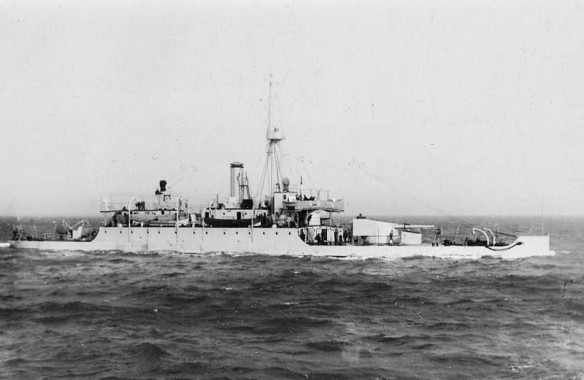
The three heavily-armed and armoured vessels of the Humber class were originally designed by Vickers for the Brazilian Navy, to complement the South American dreadnought race. Just as with the battleship Rio de Janeiro, the Brazilians found themselves unable to pay for the completed river monitors. Henry Wickham, a British botanist and explorer, had secretly stolen thousands of Hevea seeds out of the Brazilian jungle. Grown and propagated at Kew, they had provided the genetic stock for rubber plantations in Malaya and elsewhere. The industrial scale harvesting of the rubber in Malaya ruined the cottage-industry rubber growers in Brazil, and the country’s economy collapsed. Vickers found no buyers for the river monitors, even though the Romanians inspected them. (Presumably in 1914 it would have been impossible to deliver them via the Dardanelles, and they were never designed to be broken down and transported in sections.)
At the same time as he placed machine-gunners on the gangplanks to prevent the Turkish crewmen from boarding Rio de Janeiro to sail her home, Churchill requisitioned the three Brazilian river monitors. The Royal Navy had no immediate plans for their employment, but it was felt necessary to prevent their sale to another Power.
When they ran their RN trials, it was found that none of the three could attain their contract speed of 12 knots. In fact, at full load displacement and with several months’ hull fouling, none could even reach 10 knots. In any side wind on the high sea, they were simply blown sideways, and their decks were awash in even moderate swells. It was also quickly discovered that they could not be steered going astern. To remedy this a hinged flap was fitted on the stern above the propeller cavity. Another fault emerged during gunnery trails, when a pair of strengthening straps had to be bolted along the top side of the boat deck, continuing down to the foredeck, to remedy a structural weakness at the join of the foredeck and superstructure.
Once modified, the three soon proved their worth in bombarding the advancing German troops on the Belgian coast with their 6in guns and 4.7in howitzers. In fact, before they were withdrawn because of increased U-boat activity (one had even fired a torpedo at Severn which passed underneath her thanks to her shallow draught), both Severn and Mersey had worn out their turret guns. As no spares were available for the special Vickers design, both ships had the turret removed, and single 6in guns fitted fore and aft. To allow space on the quarterdeck, the two 4.7in howitzers had to be moved up to halfway along the boat deck. The RN also took the opportunity to double the thickness of the armoured deck over the magazines.
Thus rearranged, the trio were shored up and towed to the Mediterranean, for possible deployment at Gallipoli. Humber stayed in the Med, seeing action at Gallipoli and Mersa Matruh, and finishing the Great War as guardship at the Southern end of the Suez Canal. Her two sisters carried on with their epic voyage to the Rufiji Delta, where the German light cruiser Königsberg was holed up for engine repairs after sinking HMS Pegasus at Zanzibar. Blockading cruisers drew too much water to be able to come within gun range of Königsberg’s hiding place.
With the aid of spotting aircraft, the two shallow-draught monitors carried out two attacks. The first ended when a hidden German spotter brought accurate shellfire down on Mersey, damaging her and forcing both monitors to withdraw after scoring just three hits on Königsberg. During their second attack, they succeeded in crippling the German cruiser, and her captain detonated two torpedo warheads to scuttle his ship. Her 10.5cm guns were to turn up again on the East African battlefield, one even arming the Graf von Götzen on Lake Tanganyika.
After their successful mission the two monitors provided gunfire support for land forces, and at the end of hostilities sailed up the Danube. Then in 1919 all three were earmarked for North Russia, but in fact only Humber was deployed.
Launched:
Humber 17 June 1913, Severn 19 August 1913, Mersey 30 September 1913 by Vickers, Son & Maxim, Barrow.
Dimensions:
Displ: 1,155 tons light, 1,520 tons full load; L: 81.3m/266ft 9in; B: 14.9m/49ft; D: 1.32m/4ft 4in light, 5ft 7½in full load.
Crew:
9 officers + 131 men.
Power/Speed:
Twin screws; VTE steam engines, 1,450ihp/9.5 knots.
Guns/Armour:
As designed: 1 × twin 6in; 2 × 4.7in howitzers; 4 × 3-pounder QF; 6 × 7mm Hotchkiss MG /4in turret face and conning tower sides; 1½in (38mm) to 3in (76mm) hull sides; deck 1in (25mm) to 2in (50mm). As modified: Humber: twin turret + I × single 6in; + 3in HA. Severn and Mersey: 2 × single 6in.
Fate:
Severn and Mersey sold for scrap 1921; Humber converted to crane barge 1920, scrapped after 1945?